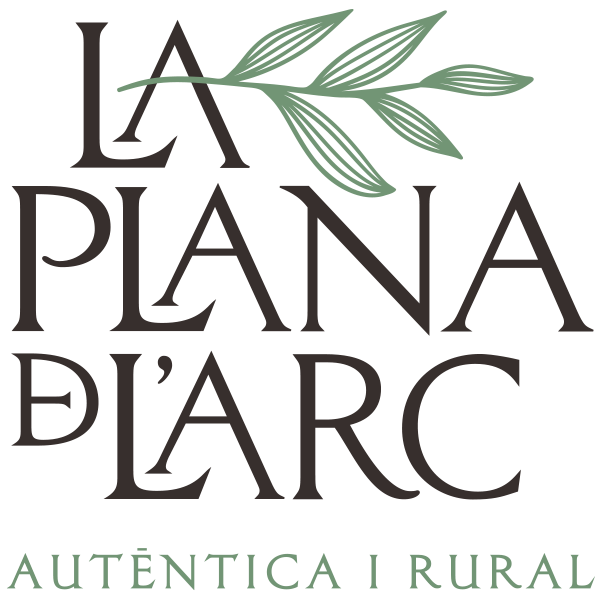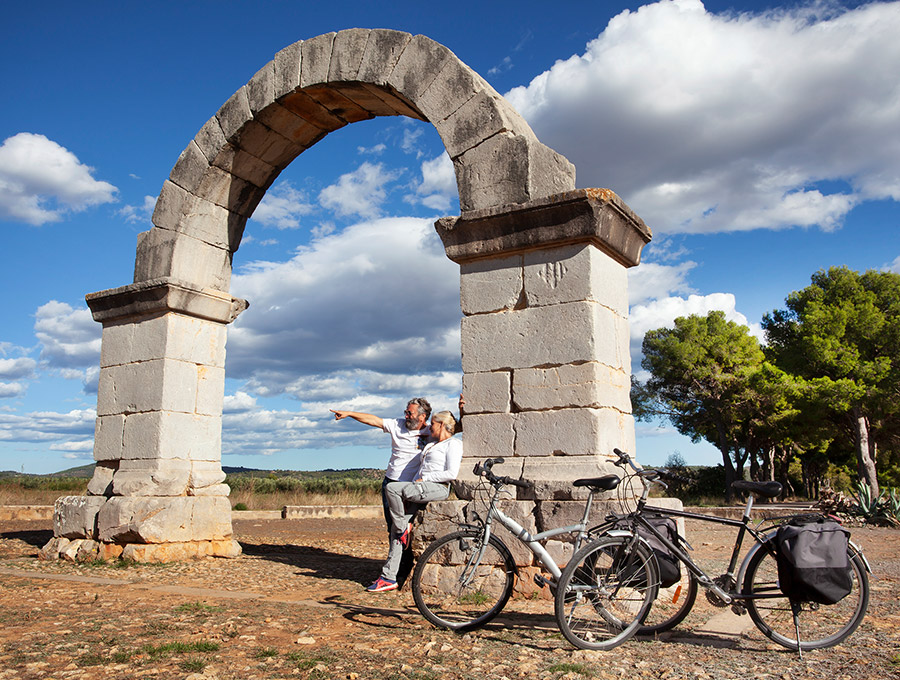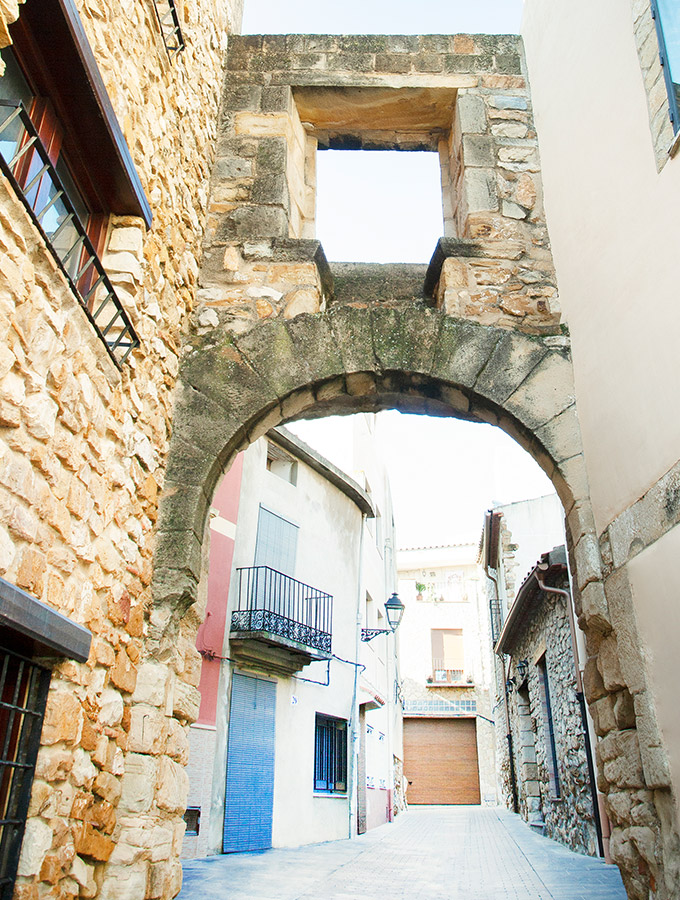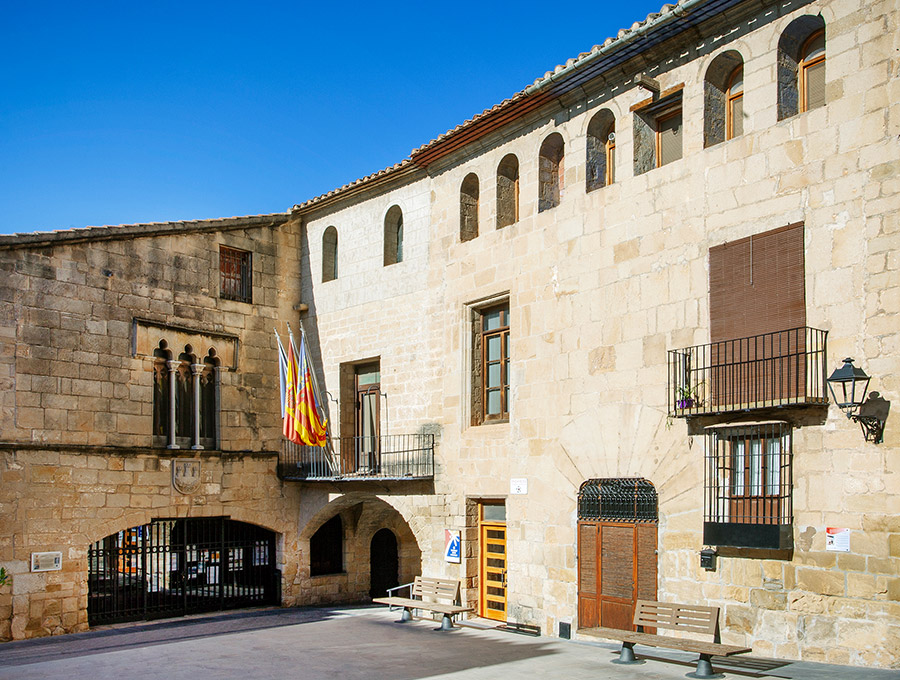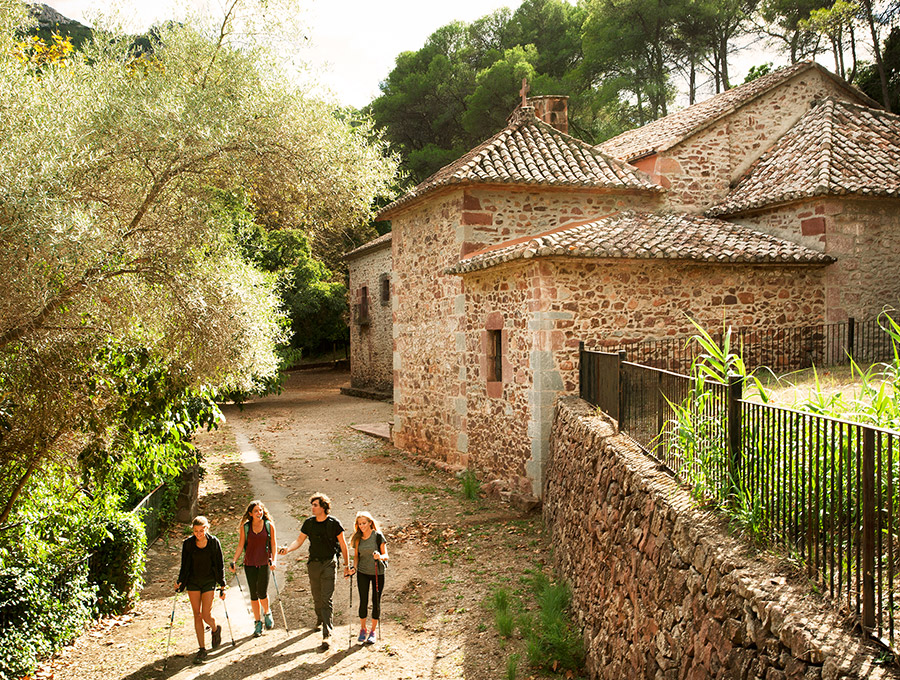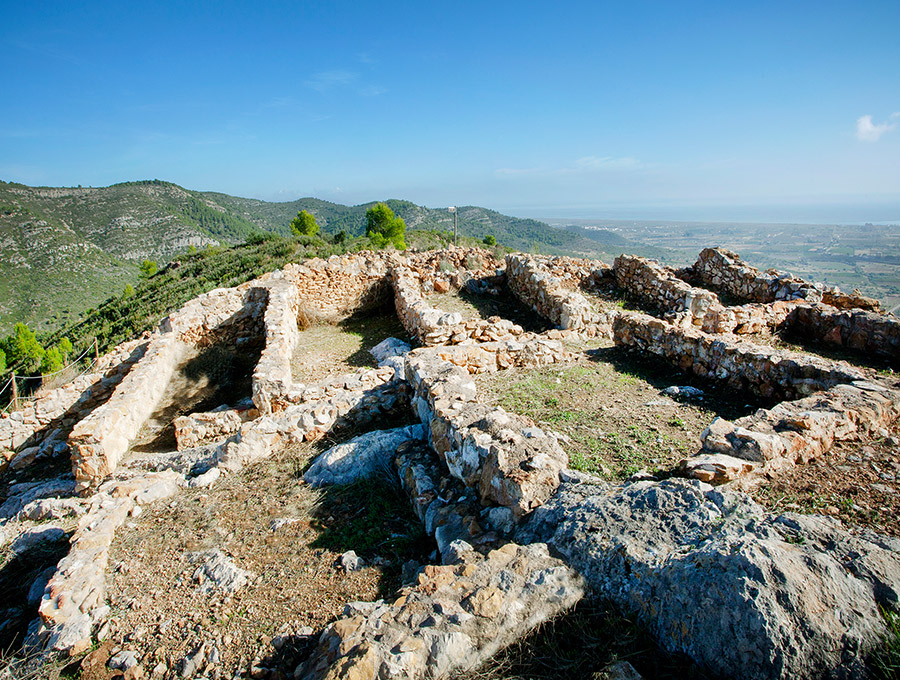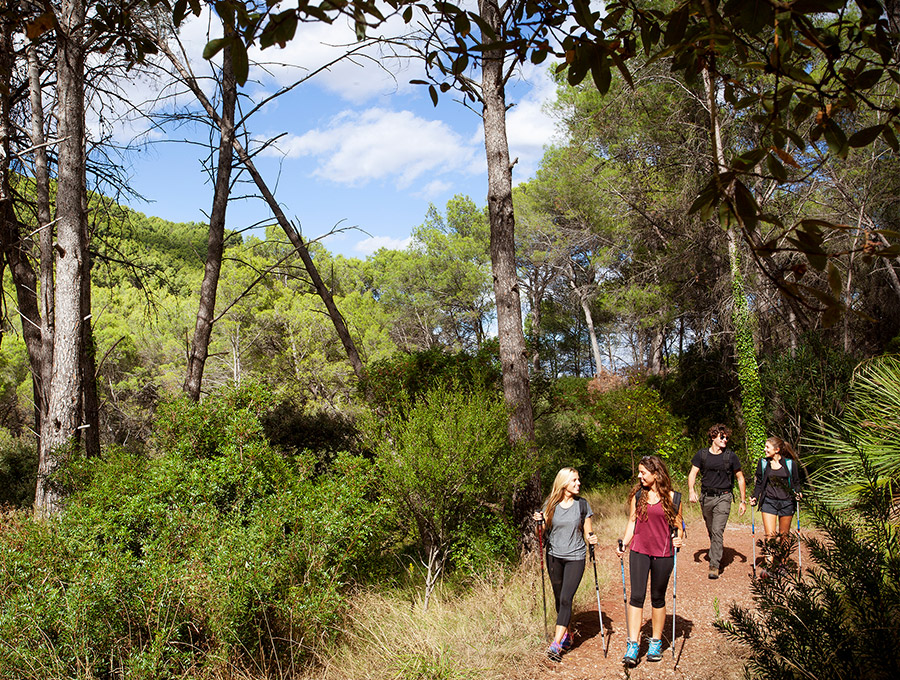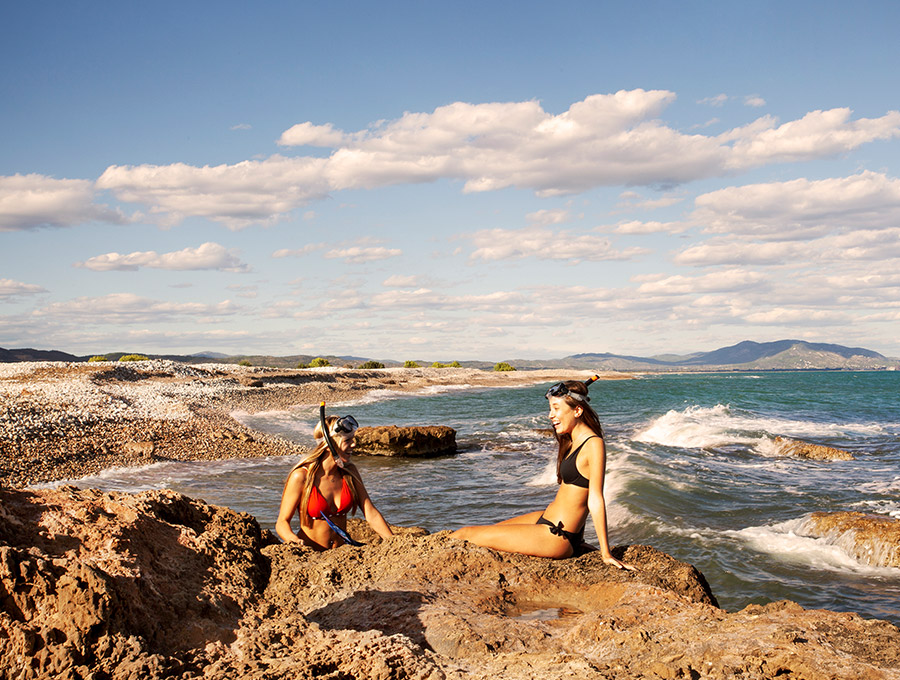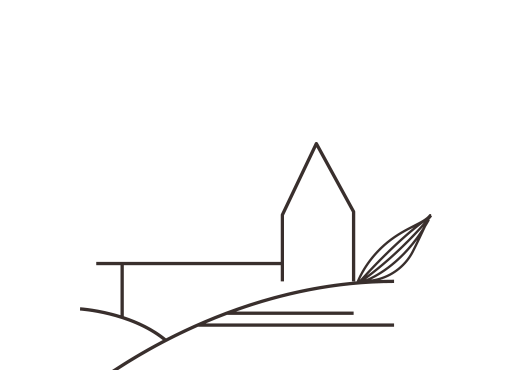Things to see
in Cabanes
Take the time to enjoy yourself
There is a lot to see in Cabanes; and a lot to feel, to smell, to walk around, to laugh, and to be moved by.
Cabanes is one of the paradises that the province of Castelló has to offer. Its extensive municipal area, more than 130 km long, stretching all the way to the coast, shows the diversity of the Mediterranean landscape. Two nature reserves coexist in this area: Prat de Cabanes-Torreblanca, the main wetland in the province of Castelló, and Desert de les Palmes Nature Reserve. There are also more than 6 km of unspoilt beaches, together with extensive historical and cultural heritage. There are things to see in Cabanes that you will never forget.
Cultural heritage
HISTORIC BUILDINGS
Arc Romà de Cabanes
Legend has it that a great stealthy moon watched the Cabanes Roman Arch being built in a single night. The astonished inhabitants of these lands found it standing strong the next day, not knowing where it came from. This monument from the Roman Empire, dating from the 2nd century AD, with the structure of a triumphal arch, still whispers secrets that you can feel if you stand close to the large limestone blocks. Built of granite ashlars joined together without mortar, the pillars on which it rests have been preserved. 2 km from Cabanes on Via Augusta, today known as Camí dels Romans, it is one of the most important pieces of Valencian archaeological heritage.
TOWN WALLS
Portal de Sitjar
Who do you owe your name to? An ancestor, a place, the movies? The Portal de Sitjar gate owes its name to the location in which it is situated, a place of pure magic: “Sitjar: a place rich in silos”. In the past, the square was an underground silo where taxes and harvests were kept. As you pass through the gate, you feel the heartbeat of the stone that tells you its history, the remains of the walls and fortifications that protected Cabanes during the Middle Ages. Of the four large gates built in the 14th century and preserved until 1857, through which the old farmhouse was accessed, Portal de Sitjar, which connects Plaça del Sitjar square with Carrer del Carme street, still maintains its vigour and firmly compels us to gaze on it.
Sant Antoni Gate Buttress
Medieval life lives on in the streets of Cabanes. For centuries, it was a completely walled site. Today, you can still see some of the parts of the old site, such as the unmissable Sant Antoni buttress at one of the old entrance gates to the town from the southern sector.
PRIVATE HOMES
Gothic oven/Forn de Sitjar
Did you know that in the olden days people used to mark their bread so they could identify it later? History always whispers riddles with rich answers, sometimes carved in stone. At the entrance to the Sitjar oven, you can see marks on the stones caused when people sharpened the knives that were to be used to mark the food. This oven, built in the 13th century and donated by King Jaume I to the bishop of Tortosa, together with flour mills and smithies, was an important source of feudal income. It is as if we can still feel the sensual aroma of freshly baked bread between the diaphragm arches and the wooden roof in this Gothic building that has now been fitted out as a guesthouse and has been declared a Site of Local Relevance.
Watchtower
This valiant tower, located outside the walls of the old medieval town, is the closest one to the ancient settlement that still stands. The tower was used to watch and observe the access from the northern road to Sant Mateu, the capital of Maestrazgo. What strategy is suggested by building a solitary tower outside a walled site? If the enemy tried to penetrate the wall, they would be caught in the crossfire between the defenders in this tower and those on the wall.
Town Hall / Municipal Palace
Inert materials undoubtedly form the heart of the centuries. Stone, iron and wood reflect the essence of the old Bishops’ Palace in Tortosa, which today houses the Town Hall. The exterior of this 15th-century Valencian Gothic building, located in Plaça de l’Església square, catches your attention with its arcade overlooking Sant Mateu street and its window with trilobe arches. The former men’s prison was under the arcade and the women’s prison was inside. This building, which has witnessed the passing of so many centuries, was bombarded during the Civil War and part of its façade was completely demolished. Fortunately, Cabanes’s efforts have restored it to its original beauty and even brought to light architectural details that lay hidden for centuries.
Former Abbey House
In the old layout of the Muslim farmstead, in the town’s historical centre, stands this imposing mansion, where the parish priest of Cabanes formerly lived. However, its architecture, with elements such as loopholes (deep, narrow, vertical openings) to shoot crossbows or arrows while offering the enemy practically no target, reveal the defensive purposes of the building’s original construction.
House with stones from the Roman arch
Who said DIY or “Do It Yourself” is not as old as mankind? It certainly is, but fortunately today it is done in a different way. Over the centuries, parts of the Roman Arch of Cabanes were plundered and reused by the local inhabitants. They can be found as water drinking troughs in Pou de Roca or private homes.
CASTLES AND FORTRESSES
La Sal Tower / Watchtower
Salt is the only rock edible by humans and, in Cabanes, it is also a beach and a fortress. La Sal Tower is a great watchtower that shares its name with the beach and evokes the area’s salt mines. Since the end of the 15th century and the beginning of the 16th century, Cabanes has had five defensive towers that were part of the network of towers on the Valencian coast. It has a square floor plan 6.50 metres wide. It has ashlars on the corners and irregular masonry in the rest of the construction. These towers, which today line the coastline, were strategically built along the territory and communicated with each other with fire and smoke signals to warn of pirate attacks.
Carmelet Tower
The conservation of this tower, dating from the 15th and 16th centuries, is impressive. When you see it you will be amazed by its square structure with a ground floor, two upper floors and a flat, accessible roof. There are sentry boxes on two opposite corners and a machicolation on the southeast façade, where the entrance gate is located. The roof is decorated with horizontal loopholes. The tower is made of masonry with ashlars at the corners and the door and window frames. One ornamental aspect is the coat of arms above the entrance door.
Gats Tower
This imposing tower is named after its last owners, the Gats (who surname was Falcó). The fortress was built in the late 15th and early 16th centuries in response to the threat posed by the Barbary corsairs who sailed the Mediterranean Sea. It has a square floor plan, 5.15 m wide, two upper floors and a flat, accessible roof. There are two round sentry boxes on opposite corners. There is a horizontal loophole on the roof and two square windows can be seen on the southeast façade. The tower is made of masonry reinforced at the corners and on the door and window frames with ashlars.
Carme Tower
Standing sleepily in the afternoon sun, between fields of crops, is Carme Tower in the Xinxilla river valley. This fortress was built in the 15th and 16th centuries and is very close to the Prat de Cabanes-Torreblanca Nature Reserve. It has a square floor plan and three floors. There is a round sentry box on one corner and the remains of another can be seen on the opposite corner of the tower. It has four small windows and a balcony on its façade.
Albalat Chapel-Fortress and Albalat Castle
The Arabic name al-balat means “paved road”. At the foot of the castle is the church-fortress, originally within the walled site and dedicated to Nostra Senyora de l’Assumpció. The complex is built of masonry and ashlars, with ashlars reinforcing the corners. The apse and the tower were added later, the latter probably in the 16th century, during a time of intense tower construction on the Valencian coast in the face of the pirate threat.
Miravet Castle
Time travel is sometimes a dream with a touch of reality! This castle is of Muslim origin, as revealed by the magic number three: castle, cistern and village. Miravet Castle was conquered by El Cid and later was part of Pere I’s dominions. In addition to the defensive towers and walls, the well-preserved cisterns, streets and houses stand out, as well as the remains of the old church dedicated to Sant Martí and Sant Bartomeu, where you can still see the pointed, semicircular arches, as well as the quibla wall with the mihrab in the centre, which shows that it was used as a mosque before it became a church. It is impossible not to be transported back to another era when you visit it!
RELIGIOUS BUILDINGS
Sant Joan Baptista Church
The 18th-century Parish Church of Sant Joan Baptista stands out for its colossal baroque façade on which there is a large sculpture of the saint, the town’s patron saint, carved by the sculptor Cristóbal Maurat i Marco, a resident of Cabanes. The interior, also baroque, has three naves, a spacious transept and a large dome, and is the second-largest church in the Diocese of Segorbe-Castelló. It has a sturdy bell tower housing La Grossa, a unique bell much loved by those who live in Cabanes. Inside are works by the painters Traver Calçada and Gabriel Pastor Sanchis from Castelló. The museum collections of the parish and Mare de Déu de Les Santes Church, great cultural attractions of Cabanes, are also located here.
Calvari Chapel
Surrounded by cypress trees, we discover the complex formed by the Way of the Cross, which is located in the farmhouses built for this purpose on the hill known as “Molinet de Vent”, and the Santíssim Crist de l’Agonia Chapel. The calvary is surrounded by native vegetation that conveys the beauty of its geography.
Les Santes Chapel
It is popularly known as the Chapel of Saints Àgueda and Llúcia. Tradition has it that the saints appeared to a hermit there and told him to build a chapel. The martyr saints share the chapel with the patron saint of Cabanes, Mare de Déu del Bon Succés or Mare de Déu de les Santes. The chapel is an extensive, variegated group of buildings that includes the chapel, the hermit’s dwelling and a spacious guesthouse. There is a single nave inside. On the right-hand side is the chapel of Mare de Déu del Bon Succés, containing an image of her. The places of honour in the main altar in the presbytery are reserved for the images of Saints Àgueda and Llúcia, whose relics are also preserved there.
ARCHAEOLOGICAL SITE
Mortórum
This settlement, discovered in 1915, was inhabited between 4000 and 2500 years ago, i.e. during the Bronze Age and Early Iron Age. Most of the rooms in the settlement were used for storage, and only a few were living quarters or public areas. The artefacts recovered from the site show there were strong commercial links with the Phoenicians from whom they obtained metal items made of iron, lead and other alloys, as well as wine transported in amphorae, a hitherto unknown product that was rapidly becoming highly-prized at the time. Around 300 metres from the settlement are the remains of a burial tomb that was used in the second millennium BC, probably for people from the Mortórum settlement. Excavations recovered the remains of at least five individuals, although many more may have been laid to rest there. It is particularly interesting as it is a type of megalithic burial site that is unique in Castelló and neighbouring areas.
NATURE RESERVES
Prat de Cabanes-Torreblanca Nature Reserve
It is impossible not to fall in love with the blue of Cabanes Nature Reserve! El Prat de Cabanes – Torreblanca is a narrow coastal strip of salt marshes and shaped marshland. It is the main wetland area in the province of Castelló. Its special landscape, geological and ecological characteristics make it of great value in the context of Valencian natural heritage. Its importance has been recognised on a global scale with the inclusion of the site on the List of Wetlands of International Importance.
http://www.parquesnaturales.gva.es/es/web/pn-prat-de-cabanes-torreblanca
Desert de les Palmes Nature Reserve
The vegetation in these mountains is undoubtedly the most abundant in the whole area. So why is it called a desert? The explanation is historical and nothing to do with the landscape. In 1697, a community of monks settled there in what they called ‘deserts’, places far from the hustle and bustle of the world. Centuries later, a walk through this nature reserve nestled in a coastal mountain range in the Plana Alta region, parallel to the coast, with abundant crests and rocky outcrops, whose highest peak is El Bartolo at 729 m, continues to offer the calm of beauty and peace.
http://www.parquesnaturales.gva.es/es/web/pn-desert-de-les-palmes
BEACHES
Torre la Sal Beach
This beach in Cabanes preserves all the charm of its fishing past with the traditional fishermen’s houses standing among sand and gravel. Four defence towers stand out in the area, notably including the one it is named after, La Sal Tower. The cleanliness of its waters has led to the construction of a Marine Biology Research Centre and the Prat de Cabanes-Torreblanca Nature Reserve Information Centre.
Cudolà Beach
This heavenly pebble beach in Cabanes, El Cudolà, is located in the heart of the Prat de Cabanes Nature Reserve, the only wetland in the province of Castelló. The promenade leading to the beach reveals 2000 metres of pure Mediterranean 10 metres wide.
“Quarter Vell” Beach
The most unspoilt beach in Cabanes is called Quarter Vell with the beautiful ruins of an old carabineer barracks. This beach of rock, pebbles, gravel and sand stretches 3300 metres along the coastline and is 10 metres wide.
